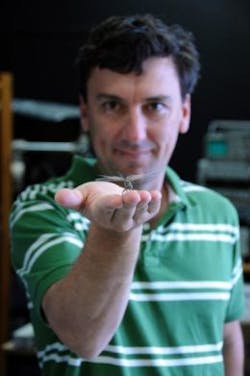Researchers hoping to mimic vision of dragonflies in robots
Two researchers from the University of Adelaide have discovered a complex visual circuit in the brain of a dragonfly that they are hoping to use to improve vision systems for robots.
Dr. Steven Wiederman and Associate Professor David O’Carroll from the University’s Centre for Neuroscience Research have determined that the brains of dragonflies combine opposite pathways – both an on and an off switch – when processing information about simple dark objects, according to a study published in The Journal of Neuroscience.
"To perceive the edges of objects and changes in light or darkness, the brains of many animals, including insects, frogs, and even humans, use two independent pathways, known as ON and OFF channels," says lead author Dr Steven Wiederman.
He continued, "Most animals will use a combination of ON switches with other ON switches in the brain, or OFF and OFF, depending on the circumstances. But what we show occurring in the dragonfly's brain is the combination of both OFF and ON switches. This happens in response to simple dark objects, likely to represent potential prey to this aerial predator.”
Wiederman explains that it is possible that many other animals could also have this same circuit for perceiving objects, not just the dragonfly.
The researchers, who were able to record their results from ‘target-selective’ neurons in the dragonflies’ brains, presented the dragonflies with moving lights that changed in intensity as well as both light and dark targets. The findings show that the responses to the dark targets were much greater than expected, and that the dragonfly’s ability to respond to a dark moving target is from the correlation of opposite contrast pathways (OFF with ON).
These findings are of great interest when it comes to solving engineering applications in target detection and tracking, and understanding how visual systems work can have a range of outcomes, such as in the development of neural prosthetics and improvements in robot vision, suggests Wiedermann.
Research is currently underway to see if the dragonfly’s vision and movement can be emulated into a robot.
View the Journal of Neuroscience study.
Also check out:
Personalized vision-enabled robots for older adults
How robots could remove blood clots with medical imaging and steerable needles
Vision guided robotics system wins Smart Vision Lights application contest
Share your vision-related news by contacting James Carroll, Senior Web Editor, Vision Systems Design
To receive news like this in your inbox, click here.
Join our LinkedIn group | Like us on Facebook | Follow us on Twitter | Check us out on Google +
About the Author

James Carroll
Former VSD Editor James Carroll joined the team 2013. Carroll covered machine vision and imaging from numerous angles, including application stories, industry news, market updates, and new products. In addition to writing and editing articles, Carroll managed the Innovators Awards program and webcasts.
